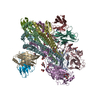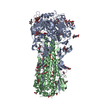[English] 日本語
 Yorodumi
Yorodumi- PDB-7kc1: Cryo-EM structure of SRR2899884.46167H+MEDI8852L fab in complex w... -
+ Open data
Open data
- Basic information
Basic information
| Entry | Database: PDB / ID: 7kc1 | |||||||||||||||
|---|---|---|---|---|---|---|---|---|---|---|---|---|---|---|---|---|
| Title | Cryo-EM structure of SRR2899884.46167H+MEDI8852L fab in complex with Victoria HA | |||||||||||||||
 Components Components |
| |||||||||||||||
 Keywords Keywords |  IMMUNE SYSTEM / Flu / HA / HV6-1 / VRC / IMMUNE SYSTEM / Flu / HA / HV6-1 / VRC /  IMMUNE SYSTEM-Viral Protein complex IMMUNE SYSTEM-Viral Protein complex | |||||||||||||||
| Function / homology |  Function and homology information Function and homology information viral budding from plasma membrane / clathrin-dependent endocytosis of virus by host cell / host cell surface receptor binding / apical plasma membrane / fusion of virus membrane with host plasma membrane / fusion of virus membrane with host endosome membrane / viral budding from plasma membrane / clathrin-dependent endocytosis of virus by host cell / host cell surface receptor binding / apical plasma membrane / fusion of virus membrane with host plasma membrane / fusion of virus membrane with host endosome membrane /  viral envelope / virion attachment to host cell / host cell plasma membrane / virion membrane viral envelope / virion attachment to host cell / host cell plasma membrane / virion membraneSimilarity search - Function | |||||||||||||||
| Biological species |    Influenza A virus Influenza A virus   Human immunodeficiency virus 1 Human immunodeficiency virus 1  Homo sapiens (human) Homo sapiens (human) | |||||||||||||||
| Method |  ELECTRON MICROSCOPY / ELECTRON MICROSCOPY /  single particle reconstruction / single particle reconstruction /  cryo EM / Resolution: 3.41 Å cryo EM / Resolution: 3.41 Å | |||||||||||||||
 Authors Authors | Gorman, J. / Kwong, P.D. | |||||||||||||||
| Funding support |  United States, 4items United States, 4items
| |||||||||||||||
 Citation Citation |  Journal: Front Immunol / Year: 2021 Journal: Front Immunol / Year: 2021Title: Sequence-Signature Optimization Enables Improved Identification of Human HV6-1-Derived Class Antibodies That Neutralize Diverse Influenza A Viruses. Authors: Gwo-Yu Chuang / Chen-Hsiang Shen / Crystal Sao-Fong Cheung / Jason Gorman / Adrian Creanga / M Gordon Joyce / Kwanyee Leung / Reda Rawi / Lingshu Wang / Eun Sung Yang / Yongping Yang / ...Authors: Gwo-Yu Chuang / Chen-Hsiang Shen / Crystal Sao-Fong Cheung / Jason Gorman / Adrian Creanga / M Gordon Joyce / Kwanyee Leung / Reda Rawi / Lingshu Wang / Eun Sung Yang / Yongping Yang / Baoshan Zhang / Yi Zhang / Masaru Kanekiyo / Tongqing Zhou / Brandon J DeKosky / Barney S Graham / John R Mascola / Peter D Kwong /  Abstract: Sequence signatures of multidonor broadly neutralizing influenza antibodies can be used to quantify the prevalence of B cells with virus-neutralizing potential to accelerate development of broadly ...Sequence signatures of multidonor broadly neutralizing influenza antibodies can be used to quantify the prevalence of B cells with virus-neutralizing potential to accelerate development of broadly protective vaccine strategies. Antibodies of the same class share similar recognition modes and developmental pathways, and several antibody classes have been identified that neutralize diverse group 1- and group 2-influenza A viruses and have been observed in multiple human donors. One such multidonor antibody class, the HV6-1-derived class, targets the stem region of hemagglutinin with extraordinary neutralization breadth. Here, we use an iterative process to combine informatics, biochemical, and structural analyses to delineate an improved sequence signature for HV6-1-class antibodies. Based on sequence and structure analyses of known HV6-1 class antibodies, we derived a more inclusive signature (version 1), which we used to search for matching B-cell transcripts from published next-generation sequencing datasets of influenza vaccination studies. We expressed selected antibodies, evaluated their function, and identified amino acid-level requirements from which to refine the sequence signature (version 2). The cryo-electron microscopy structure for one of the signature-identified antibodies in complex with hemagglutinin confirmed motif recognition to be similar to known HV6-1-class members, MEDI8852 and 56.a.09, despite differences in recognition-loop length. Threading indicated the refined signature to have increased accuracy, and signature-identified heavy chains, when paired with the light chain of MEDI8852, showed neutralization comparable to the most potent members of the class. Incorporating sequences of additional class members thus enables an improved sequence signature for HV6-1-class antibodies, which can identify class members with increased accuracy. | |||||||||||||||
| History |
|
- Structure visualization
Structure visualization
| Movie |
 Movie viewer Movie viewer |
|---|---|
| Structure viewer | Molecule:  Molmil Molmil Jmol/JSmol Jmol/JSmol |
- Downloads & links
Downloads & links
- Download
Download
| PDBx/mmCIF format |  7kc1.cif.gz 7kc1.cif.gz | 403.9 KB | Display |  PDBx/mmCIF format PDBx/mmCIF format |
|---|---|---|---|---|
| PDB format |  pdb7kc1.ent.gz pdb7kc1.ent.gz | 332.7 KB | Display |  PDB format PDB format |
| PDBx/mmJSON format |  7kc1.json.gz 7kc1.json.gz | Tree view |  PDBx/mmJSON format PDBx/mmJSON format | |
| Others |  Other downloads Other downloads |
-Validation report
| Arichive directory |  https://data.pdbj.org/pub/pdb/validation_reports/kc/7kc1 https://data.pdbj.org/pub/pdb/validation_reports/kc/7kc1 ftp://data.pdbj.org/pub/pdb/validation_reports/kc/7kc1 ftp://data.pdbj.org/pub/pdb/validation_reports/kc/7kc1 | HTTPS FTP |
|---|
-Related structure data
| Related structure data |  22804MC M: map data used to model this data C: citing same article ( |
|---|---|
| Similar structure data |
- Links
Links
- Assembly
Assembly
| Deposited unit | 
|
|---|---|
| 1 |
|
- Components
Components
-Protein , 2 types, 6 molecules ACGBDI
| #1: Protein |  Mass: 38515.629 Da / Num. of mol.: 3 Source method: isolated from a genetically manipulated source Source: (gene. exp.)    Influenza A virus / Gene: HA / Production host: Influenza A virus / Gene: HA / Production host:   Homo sapiens (human) / References: UniProt: L0HR89 Homo sapiens (human) / References: UniProt: L0HR89#2: Protein |  Mass: 25259.078 Da / Num. of mol.: 3 Source method: isolated from a genetically manipulated source Source: (gene. exp.)    Influenza A virus, (gene. exp.) Influenza A virus, (gene. exp.)    Human immunodeficiency virus 1 Human immunodeficiency virus 1Gene: HA / Production host:   Homo sapiens (human) / References: UniProt: A0A2P1E3C0, UniProt: M1E1E4 Homo sapiens (human) / References: UniProt: A0A2P1E3C0, UniProt: M1E1E4 |
|---|
-Antibody , 2 types, 6 molecules HEJLFK
| #3: Antibody |  Fragment antigen-binding Fragment antigen-bindingMass: 24292.277 Da / Num. of mol.: 3 Source method: isolated from a genetically manipulated source Source: (gene. exp.)   Homo sapiens (human) / Production host: Homo sapiens (human) / Production host:   Homo sapiens (human) Homo sapiens (human)#4: Antibody |  Fragment antigen-binding Fragment antigen-bindingMass: 22450.832 Da / Num. of mol.: 3 Source method: isolated from a genetically manipulated source Source: (gene. exp.)   Homo sapiens (human) / Production host: Homo sapiens (human) / Production host:   Homo sapiens (human) Homo sapiens (human) |
|---|
-Sugars , 3 types, 27 molecules 
| #5: Polysaccharide | alpha-D-mannopyranose-(1-3)-[alpha-D-mannopyranose-(1-6)]beta-D-mannopyranose-(1-4)-2-acetamido-2- ...alpha-D-mannopyranose-(1-3)-[alpha-D-mannopyranose-(1-6)]beta-D-mannopyranose-(1-4)-2-acetamido-2-deoxy-beta-D-glucopyranose-(1-4)-2-acetamido-2-deoxy-beta-D-glucopyranose  / Mass: 910.823 Da / Num. of mol.: 9 / Mass: 910.823 Da / Num. of mol.: 9Source method: isolated from a genetically manipulated source #6: Polysaccharide |  / Mass: 586.542 Da / Num. of mol.: 3 / Mass: 586.542 Da / Num. of mol.: 3Source method: isolated from a genetically manipulated source #7: Sugar | ChemComp-NAG /  N-Acetylglucosamine N-Acetylglucosamine |
|---|
-Details
| Has ligand of interest | N |
|---|
-Experimental details
-Experiment
| Experiment | Method:  ELECTRON MICROSCOPY ELECTRON MICROSCOPY |
|---|---|
| EM experiment | Aggregation state: PARTICLE / 3D reconstruction method:  single particle reconstruction single particle reconstruction |
- Sample preparation
Sample preparation
| Component |
| ||||||||||||||||||
|---|---|---|---|---|---|---|---|---|---|---|---|---|---|---|---|---|---|---|---|
| Molecular weight | Experimental value: NO | ||||||||||||||||||
| Source (natural) | Organism:    Influenza A virus Influenza A virus | ||||||||||||||||||
| Source (recombinant) | Organism:   Homo sapiens (human) Homo sapiens (human) | ||||||||||||||||||
| Buffer solution | pH: 7.4 | ||||||||||||||||||
| Buffer component | Formula: PBS | ||||||||||||||||||
| Specimen | Conc.: 2 mg/ml / Embedding applied: NO / Shadowing applied: NO / Staining applied : NO / Vitrification applied : NO / Vitrification applied : YES : YES | ||||||||||||||||||
| Specimen support | Grid material: COPPER / Grid type: C-flat-1.2/1.3 | ||||||||||||||||||
Vitrification | Instrument: FEI VITROBOT MARK IV / Cryogen name: ETHANE / Humidity: 90 % / Chamber temperature: 293 K |
- Electron microscopy imaging
Electron microscopy imaging
| Experimental equipment |  Model: Titan Krios / Image courtesy: FEI Company |
|---|---|
| Microscopy | Model: FEI TITAN KRIOS |
| Electron gun | Electron source : :  FIELD EMISSION GUN / Accelerating voltage: 300 kV / Illumination mode: FLOOD BEAM FIELD EMISSION GUN / Accelerating voltage: 300 kV / Illumination mode: FLOOD BEAM |
| Electron lens | Mode: BRIGHT FIELD Bright-field microscopy / C2 aperture diameter: 70 µm Bright-field microscopy / C2 aperture diameter: 70 µm |
| Specimen holder | Specimen holder model: FEI TITAN KRIOS AUTOGRID HOLDER |
| Image recording | Average exposure time: 10 sec. / Electron dose: 71.06 e/Å2 / Detector mode: COUNTING / Film or detector model: GATAN K2 SUMMIT (4k x 4k) / Num. of grids imaged: 1 / Num. of real images: 10024 |
| Image scans | Movie frames/image: 50 |
- Processing
Processing
| Software | Name: PHENIX / Version: dev_3965: / Classification: refinement | ||||||||||||||||||||||||||||||||
|---|---|---|---|---|---|---|---|---|---|---|---|---|---|---|---|---|---|---|---|---|---|---|---|---|---|---|---|---|---|---|---|---|---|
| EM software |
| ||||||||||||||||||||||||||||||||
CTF correction | Type: PHASE FLIPPING AND AMPLITUDE CORRECTION | ||||||||||||||||||||||||||||||||
3D reconstruction | Resolution: 3.41 Å / Resolution method: FSC 0.143 CUT-OFF / Num. of particles: 29735 / Symmetry type: POINT | ||||||||||||||||||||||||||||||||
| Atomic model building | Protocol: FLEXIBLE FIT / Space: REAL | ||||||||||||||||||||||||||||||||
| Atomic model building | PDB-ID: 4O5N | ||||||||||||||||||||||||||||||||
| Refine LS restraints |
|
 Movie
Movie Controller
Controller










 PDBj
PDBj










